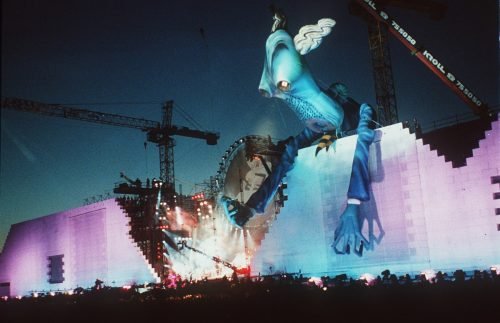Pink Floyd stands as a monumental force in the realms of both music and visual art, shaping the cultural landscape with their innovative soundscapes and striking visual presentations. Emerging in the late 1960s, the band quickly distinguished themselves not only through their progressive rock compositions but also through their pioneering use of visual elements. Their work transcended conventional boundaries, merging audio and visual art to create immersive, multi-sensory experiences.
The significance of Pink Floyd’s visual art is evident in their meticulously crafted album covers, which often encapsulate the thematic essence of their music. Collaborations with visionary artists like Storm Thorgerson and Gerald Scarfe resulted in some of the most iconic imagery in rock history, such as the prism on “The Dark Side of the Moon” and the haunting illustrations for “The Wall.” These covers do more than merely package the music; they extend the narrative, offering a visual entry point into the album’s conceptual world.
Beyond the album art, Pink Floyd’s stage shows revolutionized live music performances. Their concerts were renowned for their elaborate light shows, innovative use of projections, and grandiose stage designs. From the psychedelic light displays of their early gigs to the complex, theatrical productions of “The Wall” and the technologically advanced “Pulse” tour, Pink Floyd’s live performances set new standards for concert visual art.
Iconic Album Covers
“The Dark Side of the Moon”
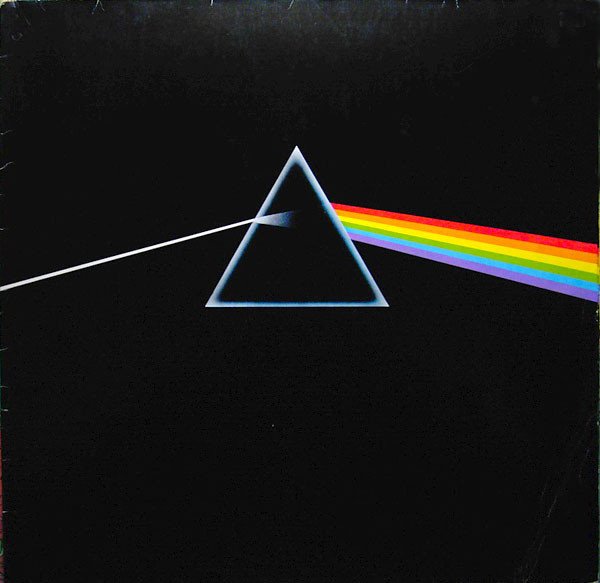
The album cover for “The Dark Side of the Moon” is one of the most recognizable and celebrated designs in music history. Created by Storm Thorgerson and his design group, Hipgnosis, the cover features a simple yet striking image of a prism refracting light into a spectrum of colors against a black background. This design symbolizes the band’s exploration of themes like the human experience, mental illness, and the passage of time.
The prism cover has transcended its original purpose, becoming an enduring icon in popular culture, synonymous with Pink Floyd and the progressive rock movement. Its minimalist aesthetic and profound symbolism have inspired countless artists and been reproduced on posters, T-shirts, and other merchandise, cementing its legacy as a visual masterpiece.
“Wish You Were Here”
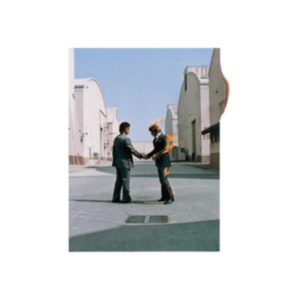
The cover of “Wish You Were Here” features a haunting photograph of two businessmen shaking hands, with one of them engulfed in flames. This image, also conceptualized by Storm Thorgerson and photographed by Aubrey Powell, captures the album’s central themes of absence, loss, and the insincerity of the music industry. The burning man symbolizes the idea of being “burned” or exploited, resonating with the band’s own experiences in the music business.
The stark, surreal quality of the photograph, set against a backdrop of a barren studio lot, enhances the feeling of isolation and alienation that permeates the album. This cover art not only visually represents the themes of the music but also stands as a powerful statement on the nature of human interactions and the emptiness of commercial success.
“Animals”
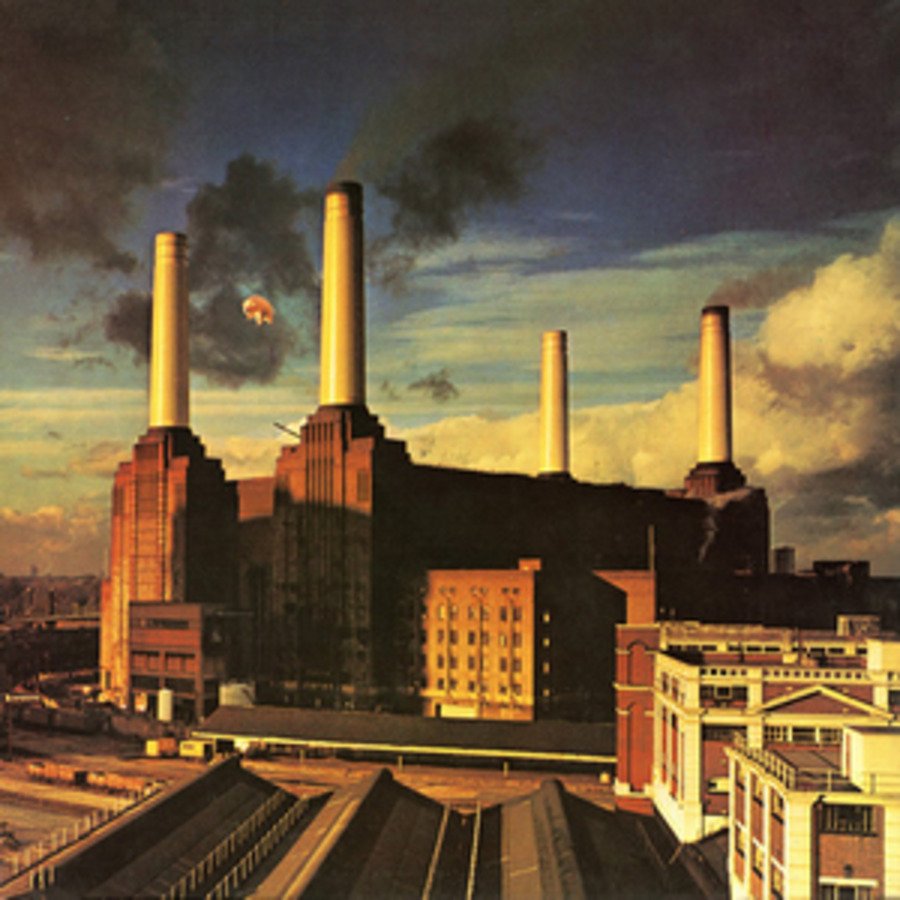
The cover of “Animals” features an image of Battersea Power Station in London, with a giant inflatable pig floating between its chimneys. This striking visual was conceived by Thorgerson and has become one of the most iconic images associated with Pink Floyd. The industrial setting of the power station symbolizes the bleak, dystopian themes explored in the album, which critiques capitalist society and its dehumanizing effects. The pig, a recurring motif in the band’s work, represents greed and corruption. The cover’s gritty, overcast atmosphere perfectly complements the album’s dark and cynical tone, creating a powerful visual metaphor for the social commentary within the music.
“The Wall”

The artwork for “The Wall” was created by illustrator Gerald Scarfe, whose distinctive, grotesque style brought the album’s themes to life. The cover features a stark white brick wall, symbolizing the barriers and isolation central to the album’s narrative. Inside the album, Scarfe’s vivid illustrations depict the story of Pink, a rock star who constructs a metaphorical wall around himself to shut out the world. These drawings, with their exaggerated and nightmarish qualities, enhance the album’s exploration of trauma, alienation, and self-destruction. Scarfe’s artwork was integral to the album’s identity, extending to the stage show and film adaptation, where his animations added a visceral and surreal dimension to the story.
“A Momentary Lapse of Reason”
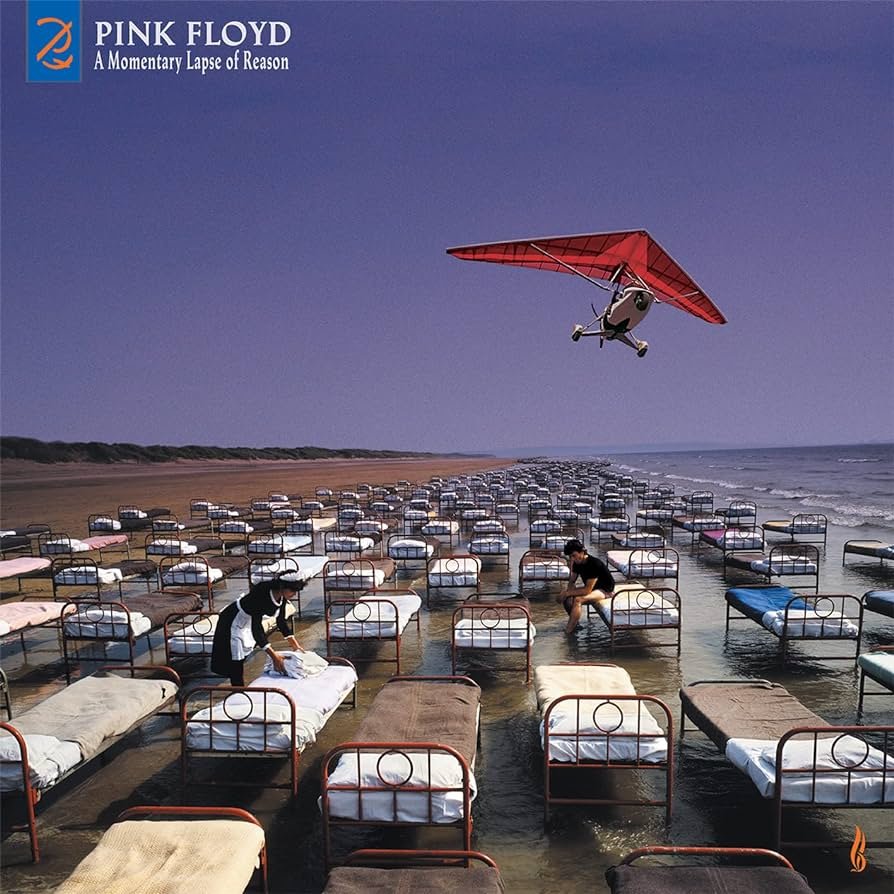
The cover for “A Momentary Lapse of Reason” features a surreal image of hundreds of hospital beds arranged on a beach, photographed by Robert Dowling and designed by Storm Thorgerson. This haunting and dreamlike scene reflects the album’s themes of memory, loss, and the passage of time. The beds, stretching out into the horizon, evoke a sense of endlessness and continuity, while the solitary figure seated on one of the beds suggests introspection and solitude.
This cover marked a significant transition for Pink Floyd, being the first album after Roger Waters’ departure, and it visually represents the band’s journey through uncertainty and the quest for a new direction. The surrealism and emotional depth of the image make it a fitting and memorable representation of the music within.
Stage Shows and Concert Visuals
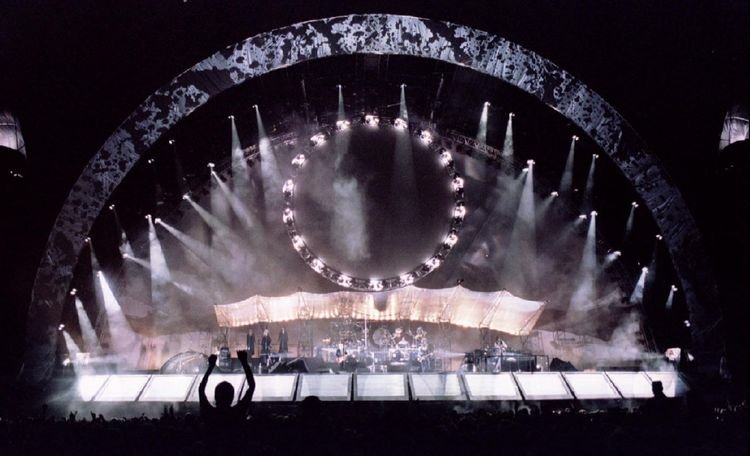
Early Experimental Shows
In the 1960s, Pink Floyd emerged as pioneers in the integration of visual art with live music, significantly influencing the future of concert experiences. Their early performances were renowned for their innovative use of light shows and projections, creating a psychedelic atmosphere that perfectly complemented their experimental sound. Utilizing rudimentary technology, the band employed oil-based light projections, color wheels, and rudimentary film loops to cast mesmerizing patterns and images onto screens behind them. These visual elements were not mere backdrops but were intricately synchronized with the music, enhancing the audience’s sensory experience and establishing Pink Floyd as trailblazers in the fusion of audio and visual art in live performances.
The Wall Live Performances
The live performances of “The Wall” were groundbreaking in their scale and complexity, setting new standards for concert production. The stage design featured an actual wall constructed between the band and the audience during the performance, symbolizing the themes of isolation and alienation central to the album. As the show progressed, bricks were gradually added to the wall until it was completely built, only to be dramatically torn down in the finale. This physical barrier served as a powerful visual metaphor for the album’s narrative.
Integral to these performances were the inflatable characters and props, including a giant pig, a teacher, and a mother, all brought to life from Gerald Scarfe’s illustrations. These inflatables, along with Scarfe’s animations projected onto the wall, created a dynamic and immersive theatrical experience. The integration of live-action elements with animation and elaborate stage design made “The Wall” concerts a revolutionary blend of rock music and visual storytelling.
Pulse Tour
The “Pulse” tour, supporting the album “The Division Bell,” featured one of the most technologically advanced and visually stunning shows in rock history. Central to this tour was the iconic circular screen, which displayed a mix of live footage, custom-made films, and computer-generated images. This circular screen became a signature element of Pink Floyd’s stage setup, symbolizing the band’s fusion of music and cutting-edge technology.
The light show on the “Pulse” tour was equally impressive, with meticulously choreographed laser displays, moving lights, and pyrotechnics that transformed each performance into a sensory spectacle. These visual elements were not only synchronized with the music but also enhanced its emotional and thematic impact, creating an immersive experience that captivated audiences worldwide. The tour’s use of advanced technology set a new benchmark for live music performances and solidified Pink Floyd’s reputation as innovators in concert visuals.
Later Tours and Performances
In their later tours, such as “The Division Bell” and “The Endless River,” Pink Floyd continued to evolve their stage design and visual elements, maintaining their commitment to creating immersive and visually spectacular shows. The “Division Bell” tour expanded on the use of the circular screen and introduced even more sophisticated light displays and stage effects. The tour featured massive stage structures, elaborate props, and high-definition video projections that created a multifaceted visual experience.
“The Endless River” tour, though more subdued, still showcased the band’s dedication to high-quality visual presentation. The stage design and lighting were carefully crafted to reflect the ambient and reflective nature of the music, creating a serene and contemplative atmosphere. This evolution in stage design demonstrated Pink Floyd’s ability to adapt and innovate while remaining true to their artistic vision, ensuring that their live performances continued to be a benchmark for visual excellence in the music industry.
Collaborations with Visual Artists

Storm Thorgerson and Hipgnosis
Storm Thorgerson and his design group, Hipgnosis, played a pivotal role in crafting the visual identity of Pink Floyd. Thorgerson, a school friend of band members Syd Barrett and Roger Waters, formed Hipgnosis with Aubrey Powell in 1968. This creative partnership began with the cover for Pink Floyd’s second album, “A Saucerful of Secrets,” and continued for many of the band’s subsequent releases.
Thorgerson’s approach to album art was innovative and often surreal, characterized by a deep conceptual connection to the music. For “The Dark Side of the Moon,” Thorgerson created the iconic prism design, which has become synonymous with Pink Floyd’s legacy. The prism’s refraction of light into a spectrum of colors symbolized the band’s exploration of sound and light, themes central to the album’s exploration of human experience.
Other notable covers include “Wish You Were Here,” featuring the famous photograph of two men shaking hands, one of them on fire, symbolizing the album’s themes of absence and corporate insincerity. For “Animals,” Thorgerson captured the dystopian essence of the music with an image of Battersea Power Station and a floating pig, critiquing industrial society and its discontents.
Hipgnosis’s work extended beyond mere album covers; it shaped the visual narrative of Pink Floyd. Their designs were integral to the band’s identity, setting them apart from their contemporaries and contributing significantly to their mystique and artistic legacy. Thorgerson’s ability to translate complex musical themes into compelling visual art ensured that Pink Floyd’s albums were not just collections of songs but holistic artistic statements.
Gerald Scarfe
Gerald Scarfe, a British illustrator known for his satirical and often grotesque style, collaborated with Pink Floyd on their seminal project “The Wall.” Scarfe’s involvement began with the album cover and extended to its stage show and film adaptation, making his contributions crucial to the project’s visual storytelling.
Scarfe’s artwork for “The Wall” is characterized by its bold, exaggerated style, which vividly brought to life the album’s themes of trauma, alienation, and psychological breakdown. His illustrations included memorable characters like the sadistic schoolmaster, the overprotective mother, and the oppressive judge, all of which were central to the album’s narrative. These characters were not only featured on the album cover but also animated in the film and used as inflatables in the live shows, adding a visceral, dynamic element to the performances.
The collaboration reached its peak with the film adaptation of “The Wall,” directed by Alan Parker. Scarfe’s animations were integral to the film, providing a nightmarish visual accompaniment to the music and further enhancing the story of Pink, the protagonist. His work added depth and a distinct visual signature to the film, making it a landmark in rock cinema.
Scarfe’s contributions extended Pink Floyd’s narrative beyond audio, creating a cohesive and immersive visual world that complemented and expanded the themes explored in the music. His distinctive style and ability to convey complex emotions through his art were instrumental in making “The Wall” not just an album, but a multifaceted artistic experience. Through his collaboration with Pink Floyd, Scarfe helped to solidify the band’s reputation for integrating powerful visual art with their music, influencing how audiences perceive and engage with their work.
Beyond Music: Visual Art Projects
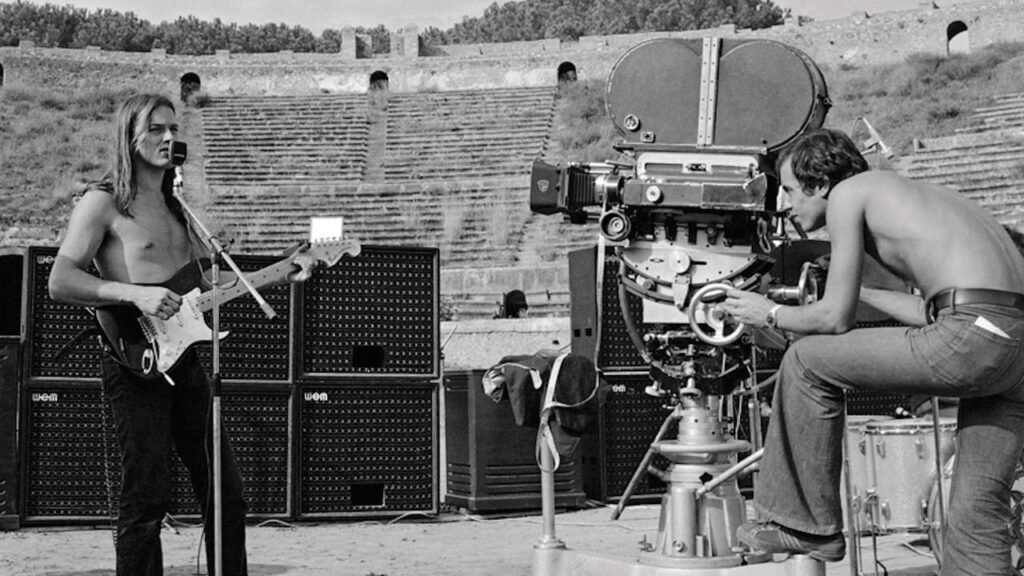
Films and Documentaries
Pink Floyd’s exploration of visual art extended beyond album covers and stage shows into the realm of films and documentaries, further solidifying their legacy as innovators in multimedia storytelling.
One of the earliest and most significant visual projects was “Pink Floyd: Live at Pompeii,” a concert film directed by Adrian Maben and released in 1972. Filmed in the ancient Roman amphitheater of Pompeii, the band performed without an audience, creating a unique and otherworldly atmosphere. The stark, volcanic landscapes and the band’s intense performances were intercut with behind-the-scenes footage and interviews, offering a raw and intimate glimpse into their creative process. The use of the desolate, historical setting combined with dramatic close-ups and sweeping camera movements provided a striking visual counterpart to Pink Floyd’s atmospheric music.
The film adaptation of “The Wall,” directed by Alan Parker and released in 1982, stands as a landmark in the fusion of music and cinema. Based on the album of the same name, the movie blends live-action and animation, with Gerald Scarfe’s distinctive illustrations coming to life on screen. The film tells the story of Pink, a rock star who isolates himself from society behind a metaphorical wall. The visual storytelling is powerful and often surreal, capturing the album’s themes of alienation, trauma, and self-destruction. The film’s intense and sometimes disturbing imagery, combined with the music, creates a visceral experience that deepens the audience’s understanding of the album’s narrative.
These visual projects demonstrated Pink Floyd’s commitment to extending their artistic vision beyond traditional music formats, using film to create immersive and multifaceted experiences that resonate on both an auditory and visual level.
Art Exhibitions
Pink Floyd’s rich visual history has been celebrated in art exhibitions, most notably “Their Mortal Remains.” This retrospective exhibition, which opened at the Victoria and Albert Museum in London in 2017, offered a comprehensive look at the band’s visual and musical legacy.
“Pink Floyd: Their Mortal Remains” featured a vast array of artifacts, including original album cover artworks, stage props, musical instruments, and rare photographs. The exhibition was meticulously curated to take visitors on a chronological journey through the band’s career, highlighting key moments and providing context for their artistic evolution.
One of the standout features was the immersive installations, such as a recreation of the “The Wall” stage show and the iconic Battersea Power Station from the “Animals” album cover. These installations allowed visitors to experience the scale and impact of Pink Floyd’s visual concepts firsthand. Interactive elements, including a 3D mix of “Comfortably Numb” from the “Pulse” tour, provided a multi-sensory engagement with the band’s work.
The exhibition underscored the integral role of visual art in Pink Floyd’s identity, showing how their collaboration with visual artists and their innovative use of stage design and film have left a lasting impact on both music and visual culture. “Their Mortal Remains” not only celebrated the band’s achievements but also contextualized their work within the broader history of rock music and visual art, ensuring that their legacy continues to inspire future generations.
Closing Thoughts

Pink Floyd’s innovative integration of visual art into their music has left an indelible mark on the cultural landscape, fundamentally transforming the way audiences experience and perceive music. From their iconic album covers to their groundbreaking stage shows and immersive film projects, the band consistently pushed the boundaries of visual and auditory creativity. Their collaborations with visionary artists like Storm Thorgerson and Gerald Scarfe resulted in some of the most memorable and influential imagery in rock history, enhancing the emotional and conceptual depth of their music.
Pink Floyd’s lasting legacy in both music and visual culture is a testament to their commitment to artistic innovation and expression. Their work has not only enriched the music industry but has also influenced broader visual arts practices, demonstrating the powerful synergy between sound and sight. As pioneers of the multimedia experience, Pink Floyd has left a legacy that transcends the confines of traditional music, continuing to inspire and influence artists across various fields. Their contributions have established a benchmark for integrating visual art into music, ensuring their place as one of the most important and influential bands in the history of rock music.
